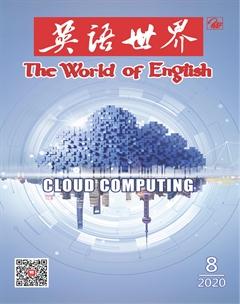云计算如何应对新冠疫情
阿德里安·布里奇沃特
The COVID-191 (Coronavirus2) contagion has resulted in a global pandemic3 with cities in lockdown and national governments being placed in crisis mode. As workers in many industries are now faced with the challenge of working from home, how will our IT frameworks be able to adapt to a ‘new shape of data flows being created?
Our always-on mobile-centric increasingly cloud-native existence has created a world where access to data services is fundamentally important to keeping business moving. While panic buying in supermarkets continues (at the time of writing) in many world cities, we need to consider whether a commensurate4 level of ‘panic provisioning5 has been going on inside the cloud datacenters that provide us with our central data infrastructure.
Provisioning procedures
Datacenter provisioning involves the preparation of the ‘server real estate base to make sure that we have enough processing power, enough memory and storage, enough connectivity (connection gateways wide enough to cope with the input/output of data) and enough ancillary6 services such as access to big data analytics engines and so on to cope with demand generated by users and (increasingly today) by intelligent machines.
Sometimes this means moving data around to clear the way for anticipated data spikes, sometimes this means putting some data and applications in locations where they can be more efficiently and cost effectively delivered… and, ultimately, sometimes this means purchasing new server units to build a bigger datacenter.
Even the cloudiest clouds
“While many customers have the ability to manage their workloads remotely, datacenters are nevertheless physical entities and even the ‘cloudiest clouds require servers to be rebooted and cables patched, by a human being. So it is worth recalling why hybrid cloud computing is so compelling; it represents the ability and choice to increase and decrease (‘spin up and ‘spin down7) data processing and storage in a flexible on-demand manner. As the crisis deepens, the challenge to the industry is whether this flexibility is delivered when and where it is needed,” said UK managing director for Interxion Andrew Fray.
As any country attempts to move towards becoming a remote working nation, Fray advises that organizations may still have to re-evaluate how theyve designed their network and applications.
“As many more thousands or even millions of remote workers try to connect from unfamiliar locations, it is inevitable that there will be some communication pinch points8. When your entire workforce is geographically remote, the network architecture and cloud architecture need to be able to cope with a diverse workload [by using Software-Defined Networking9 (SDN) technologies] so that you are not hitting the same entry point10 and negatively impacting performance,” added Interxions Fray.
Autonomous advantage
As the peak of the Coronavirus pandemic approaches, will we be able to turn back and rely on all the advances in autonomous11 computing and Artificial Intelligence (AI) that populated so many headlines prior to the outbreak? Back in September 2019 we noted that Oracle was building in layers of IT autonomy into its database12 to reduce human error. Cant the systems just get on with it by themselves now and allow us to stay at home, self-isolate and drink lots of fluids?
“The beauty of todays fully-managed cloud database is that it can be deployed and managed from anywhere with very little intervention needed by the end user. Happily, this is all by design i.e. some fully-managed cloud databases are fault-tolerant, auto-updating, self-healing, elastic-scaling and provide automated proactive management, which benefits end-users immensely as it frees them from the operational chore and costs of learning and maintaining their database infrastructure,” said Jeff Morris, VP product and solutions marketing at open source document-oriented database company Couchbase.
Can some good come from bad?
Although this discussion is clearly meant to concentrate on the data backbone impact of Coronavirus, there is an argument here to suggest that it could be part of the drive that takes us towards a more cloud-first always-virtualized world of computing. There may arguably be some good in that push i.e. cloud evangelists13 would argue that we need to ‘let go and regard the keyboard as nothing more than a conduit channel to the deeper IT services that lie within the cloud itself.
“I believe any time you have this type of scenario, be it a pandemic, 9/11, or a massive natural disaster, business priorities take on a new focus. One will certainly be about business continuity as people focus on enabling remote work from anywhere. This experience will be a stronger accelerant to a cloud-first world and a SaaS-first world that will put further pressure on the traditional datacenter world [as it] becomes part of companies architectural postures,” said Patrick Harr, CEO of Panzura, a specialist in collaborative file and data management.
With a few hiccups, coughs and glitches (hand over your mouth please) the cloud should carry us through much of the COVID-19 pandemic, computationally speaking at least. Now, please wash your hands.
COVID-19(新冠病毒)的蔓延已經在全球范围内引发疫情大流行,各大城市进入封锁状态,诸国政府正处于危机模式。许多行业的工作者都面临着在家办公的挑战,而我们的IT框架又该如何适应由此而生的“新数据流形式”?
如今,我们已然生活在一个永远在线、以移动设备为中心、云原生程度不断加深的新世界当中。在这个世界里,访问数据服务对维持业务发展至关重要。在笔者写作的此刻,许多国际都市的超市正上演着恐慌性的抢购。与此同时,我们也要思考一下,在為我们提供中央数据基础设施的云数据中心,是否也正在经历着与之程度相当的“恐慌性配置”。
配置程序
数据中心配置涉及“服务器资产”的基建,以保障我们有充足的处理能力、内存容量、网络连通性(连接的网关带宽足以应对数据的输入/输出)以及足够的辅助性服务(如对大数据分析引擎的访问等)来应对用户需求和如今与日俱增的智能设备需求。
有时,这意味着我们得迁移数据来给可以预见的数据激增腾出道路;有时,这意味着我们要将一些数据和应用存放在能使交付更高效、更划算的位置……而最终,这可能也意味着我们需要购置新的服务器单元来构建更大的数据中心。
即便是最“云”的云
Interxion英国区董事总经理安德鲁·弗雷表示:“虽然很多客户具备远程管理工作负载的能力,但数据中心毕竟仍是实体存在,即便最‘云的云也需要人工对服务器进行重启和线路接插。因此,我们有必要回顾一下混合云计算为什么能够得到强烈的认可——它让我们有能力且可以选择以灵活按需方式来增加或减少(加速或减缓)数据处理、数据存储。随着疫情危机的加重,云计算行业面临的挑战是,能否在需要它的某时某地展现这种灵活性。”
鉴于各国都在努力实现远程办公,弗雷建议各个组织仍须对其网络和应用设计进行重新评估。
他补充道:“当几千甚至几百万的远程工作人员尝试从各个陌生的地点互联,其中势必会出现一些通信窄点。当你所有的员工都距离遥远时,网络架构和云架构就需要有能力应付不同的工作负荷(通过使用软件定义网络技术),这样你就不会重复接入同一个入口点,对性能造成负面影响。”
自主化的优势
随着新冠病毒疫情高峰的逼近,我们能否回头仰赖于疫情暴发前曾屡次占领新闻头条的自主计算和人工智能先进技术?早在2019年9月,我们注意到甲骨文公司正将多项IT自治功能植入其数据库以减少人为错误。难道这些系统就不能乖乖地保持自我运行,让我们能好好待在家里自我隔离、多喝喝水吗?
Couchbase是一家面向文档的开源数据库公司,其产品与解决方案营销副总裁杰夫·莫里斯表示:“今天全托管式的云数据库,其美妙的地方在于它可以在任何地方进行部署和管理,极少需要终端用户的干预。令人高兴的是,这些都被提前设计好了,譬如一些全托管式的云数据库可以容错、自动更新、自我修复、弹性伸缩,提供自动化的主动式管理,这些让终端用户受益,令其从日常运营事务中脱身,也无须再为学习和维护数据库基础架构投入成本。”
坏事是否也有好的一面?
虽然本文的主题是新冠病毒对数据主干网带来的冲击,但现在就有一种观点认为,新冠病毒也可能促使我们走向一个更加以云为先和虚拟常态化的计算世界。这当中或许可以说不全都是坏事,譬如云技术的布道者们就会说,我们应该“看开点”,把键盘仅仅看作是一个导入更深层IT服务的通道,而这一服务就蕴藏在云技术中。
Panzura公司的首席执行官帕特里克·哈尔是一名协同文件和数据管理的专家,他表示:“我相信,无论是全球流行病还是9·11事件,抑或是一场大规模的自然灾害,遇到任何类似情况,企业首要考虑的事项都会发生变化。当中一项无疑是保持业务的持续性,因为人们会专注于能在任何地方开启远程办公模式。这种经历将会成为更强的催化剂,促使我们走向一个以云为先、以软件即服务为先的世界。随着远程办公模式成为公司架构的一部分,数据中心的传统世界会感受到更大的压力。”
虽然可能存在一些小问题,就像人会打嗝、咳嗽或有些小病恙(请用手捂嘴),但至少从计算层面来说,云计算应该能帮我们挺过此次新冠疫情。还有,记得洗手哦。
(译者为“《英语世界》杯”翻译大赛获奖者)

